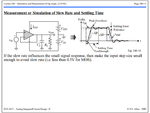Junus2012
Advanced Member level 5

Dear friends,
I am trying to simulate the Settling time of my operational amplifier. I am connecting it as a unity gain buffer and applying a step input signal.
As far as I believe that settling time is a small signal property, and therefore to simulate it we must sure that the amplifier is not slewing. However, if we see the outputput of the amplifier from any literature they still show the slew part when determining the settling time. Please see the below image from Allen Holberg. Although he was confirming to reduce the input signal step to avoide the slew rate.
Here is my first question please, what is the appropriate input step voltage properties to simulate the Settling time (Step voltage value, Pulse width, Pulse period, delay time, rising and falling time) ?
The second question is how can I know from my output signal that my amplifier is not slewing ? does it mean I should see now slope from high to low or low to high ?

I also attached you the Settling time function from Cadence calculator to refer to it in your kind explanation

Here I found one file from the internet but he is not explaining why he is taking the chosen value
View attachment settling_gain.pdf
Thank you in advance
I am trying to simulate the Settling time of my operational amplifier. I am connecting it as a unity gain buffer and applying a step input signal.
As far as I believe that settling time is a small signal property, and therefore to simulate it we must sure that the amplifier is not slewing. However, if we see the outputput of the amplifier from any literature they still show the slew part when determining the settling time. Please see the below image from Allen Holberg. Although he was confirming to reduce the input signal step to avoide the slew rate.
Here is my first question please, what is the appropriate input step voltage properties to simulate the Settling time (Step voltage value, Pulse width, Pulse period, delay time, rising and falling time) ?
The second question is how can I know from my output signal that my amplifier is not slewing ? does it mean I should see now slope from high to low or low to high ?

I also attached you the Settling time function from Cadence calculator to refer to it in your kind explanation

Here I found one file from the internet but he is not explaining why he is taking the chosen value
View attachment settling_gain.pdf
Thank you in advance







